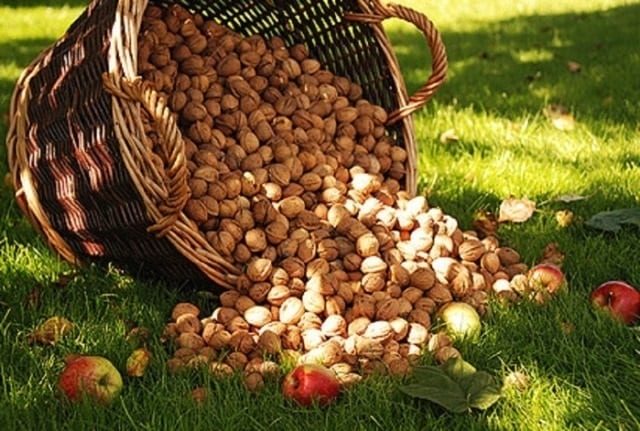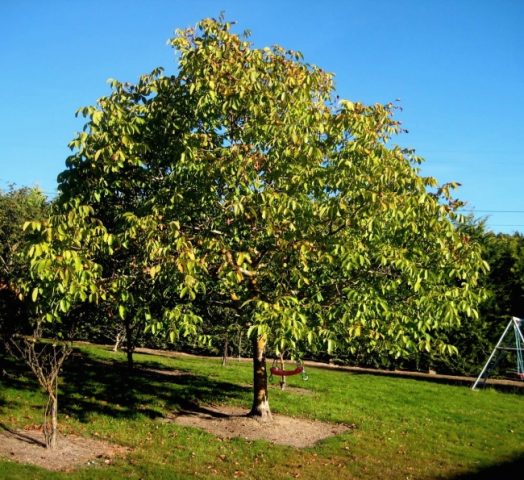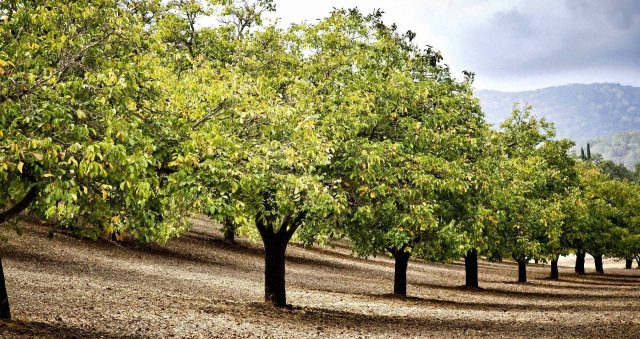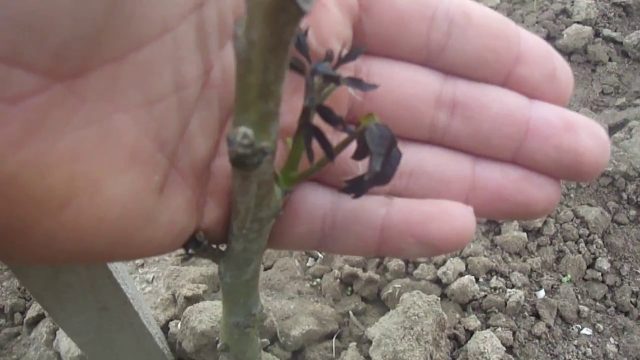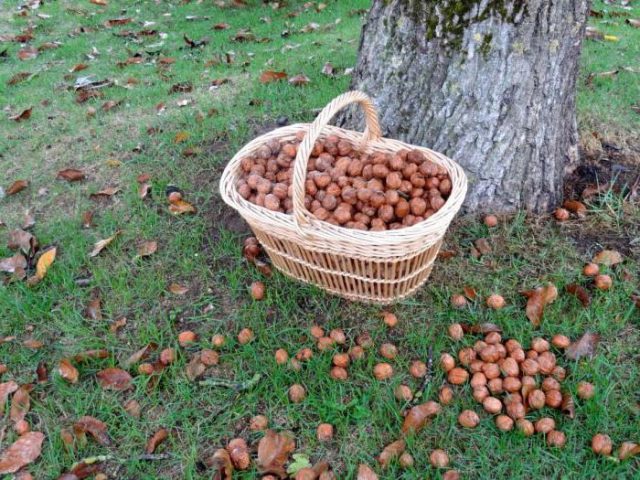Content
- 1 Is it possible to grow a walnut from a nut
- 2 When to plant walnuts
- 3 Where to plant walnuts on the site
- 4 How to germinate a walnut at home
- 5 How to plant a walnut correctly
- 6 Features of growing walnut in different regions
- 7 Walnut care
- 8 How long does a walnut bear fruit after planting
- 9 What to plant under a walnut
- 10 Reviews about the cultivation of walnuts in the Moscow region
- 11 Conclusion
Thanks to the valuable wood and tasty healthy fruits, the walnut was introduced into the culture several thousand years ago. Most modern botanists are inclined to believe that it began to be bred in Ancient Persia, then the seedlings came to Greece. From there the culture spread first to the Balkans, then to Western Europe. Now it is imperative to plant walnuts on the site not only southerners, but also residents of regions with a temperate climate.
Is it possible to grow a walnut from a nut
For centuries, walnuts have only been propagated by seeds. Varieties are created exclusively by the method of selection and acclimatization, therefore, cultivated trees in biological terms are not too different from their wild relatives. Cross-pollination with other species is possible, but has not yet yielded noteworthy results.
So trees grown from nuts may not be identical to the original variety. But they usually produce large, tasty fruits and thrive well in the region where the mother tree originates.
When to plant walnuts
Planting time for walnuts varies by region. In temperate and cold climates, the best time is spring, before the buds swell. If you plant a tree there in the fall, it is almost guaranteed to freeze out in winter. In spring, the soil warms up more and more every day, contains a lot of moisture - in such conditions the seedling takes root well, quickly restores damaged roots and starts to grow.
It is impossible to be late with the spring planting, especially in areas where there are problems with watering, or rarely visited by the owners. Moisture from the soil evaporates quickly, the leaves that have already started to grow lose it intensively. The roots cannot provide the aboveground part with water, since they themselves do not receive enough water to take root in a new place. And the temperature rises every day. As a result, walnuts often die in the first winter.
In the southern regions, on the contrary, a suitable time for planting a crop is autumn, during or after leaf fall. It is in cool weather and sufficient soil moisture that walnut roots take root best. Although there are drawbacks here - with dry autumn and snowless winter, the seedling can take root poorly, freeze slightly, and even die. Strong dry winds are especially dangerous for a young plant.
Where to plant walnuts on the site
Proper planting of walnuts is a guarantee of high yields and durability of the tree. Culture takes up a lot of space, besides, in adulthood, it does not like transplants. If we add here the allelopathic nature of the walnut, it becomes clear that the wrong location of the tree can cause a lot of problems.
The culture occupies an intermediate position between shade-tolerant and sun-loving plants. At a young age, the seedling is quite shade-tolerant.When it grows up and begins to bear fruit, the yield and further development of the tree depend on the illumination of the crown.
The walnut root system is adapted to many types of soil:
- on black soil, an adult tree generally grows without additional fertilizing;
- walnuts develop well on alkaline, lime-rich soils, loose fertile loams and sandy loams;
- it will grow on calcareous-gravel, stony-sandy, rocky soils, if they are well moistened and permeable;
- on dense, poor soils, the tree forms a small crown, grows poorly and gives few fruits;
- podzolic, acidic, blocking, cold soils inhibit development, often cause the seedling to freeze and die.
Only highly saline, swampy and dense wet clay soils are completely unsuitable for growing walnuts.
The tree will reach its maximum height and will yield the highest yields when the groundwater is no closer than 2.3 m from the surface. But the walnut is a unique, plastic culture. With a higher standing of aquifers, it simply will not grow up to 25 m.
Since the walnut in the garden is most often the tallest tree, it should be planted in the northern or western outskirts so as not to shade other crops. The place should be sunny and sheltered from the wind. When the tree grows, it will be impossible to protect it, but this will no longer be critical.
How to germinate a walnut at home
In the south, walnuts sprout as they fall to the ground. They sprout in a compost heap or sprinkled with a small layer of soil. Fruits not harvested in autumn and knocked to the ground by birds in winter easily turn into young trees. They need to be transplanted, or uprooted and thrown away as early as possible.
But, of course, it is best to grow walnuts from fruits taken from a healthy, bountiful tree. If they are placed in loose soil in the fall, seedlings will appear in May.
When planting in spring, stratification is needed. The fruits are soaked in warm water, which is changed every 12 hours for 2-3 days. They are then placed in a drainage box filled with clean, wet sand. Maintain at a temperature of 5-7 ° C for about 90 days. The substrate is constantly checked and moistened as necessary, and stirred every 10 days to saturate with oxygen.
But fruits with a thin shell, which are easy to crush with your fingers, will rot with such stratification. They are kept in clean wet sand for 30 to 45 days at room temperature.
If it is time for planting, and the seedlings have not hatched, the fruits are transferred to a room with a temperature of 25-30 ° C. There they will quickly germinate.
By May, in a place well protected from the wind, loose soil is prepared by adding leaf humus and sand. Then a groove is dug out with a depth of 7-10 cm and nuts are placed in it on the edge.
If stratification has been carried out correctly, seedlings should appear in 10 days.
How to plant a walnut correctly
Growing and caring for walnuts begins with planting. If you choose the right place and time, the culture takes root well. A tree has been growing in one place for decades, it is very difficult to replant an adult, and sometimes it is impossible, but removing it from the site requires a lot of time and effort.
How to properly plant a walnut seedling
For planting walnuts in the spring, the pit is prepared at the end of the previous season, in the fall - in 2-3 months. The top fertile soil layer is mixed with humus. On chernozems, a bucket is added, for poor soils, the amount of rotted manure is increased by 2-3 times and starting fertilizers are added. Leafy humus can be added to dense soils. In acidic soils, add from 500 g to 3 kg of lime (depending on the pH).
The depth and diameter of the planting pit depend on the fertility of the soil. On the poor, they should not be less than 100 cm, on black soil - 60 cm wide, 80 cm deep. The pit is filled with planting mixture and allowed to settle.
On the eve of planting, part of the soil is taken out of the pit and filled with water. All damaged roots are cut out from the seedling to healthy tissue, the central one is shortened, leaving 60-70 cm. Planting is carried out together in the following sequence:
- A strong peg is driven into the center of the pit.
- A seedling is installed next to it so that the root collar rises 6-8 cm above the edge of the pit.
- The tree is tied to a peg.
- One person holds the seedling, the second begins to fill the root, constantly compacting the fertile soil around it.
- When planting is complete, check the position of the root collar.
- The sides are formed from the remaining soil along the diameter of the landing pit.
- Each seedling is watered abundantly, spending 2-3 buckets of water.
- The trunk circle is mulched with humus.
How to plant a walnut from a fruit
Sprouted walnuts are dug up next spring, the root is shortened, leaving no more than 60-70 cm, and moved to a permanent place or to a school. Growing with subsequent transplanting is preferable.
The root of a walnut grows faster than the aerial part. If it is pruned several times, the quality of the wood will deteriorate, but the yield will increase significantly. In the southern suburban areas, where nuts are grown for their own consumption and some are still left on the tree, this is of little importance. But on industrial plantations and in cold or temperate climates, where trees do not grow so large, and the yield is much lower, it is significant.
Walnuts grown from seeds are transplanted several times for better fruiting, shortening the root. In farm gardens, seedlings are not transferred from place to place, and the root is cut with a special tool right in the ground.
The technology of planting a walnut grown independently from seeds is no different from that brought from a nursery.
Walnut planting scheme
There is no agreement on planting schemes for walnuts on industrial plantations. Some farmers claim that the distance between trees of 10x10 m is quite sufficient. Others are firmly convinced that this way the plantation will be able to bear fruit no longer than 20 years and plant nuts according to the 20x20 m pattern.
Perhaps both are right:
- on chernozems in warm climates, trees grow higher, the planting scheme should be sparse;
- in the middle lane on poor soils, compacted planting is possible.
Of course, varieties are also important, among them there are undersized ones. Although the crown is still spreading, they take up less space than high ones.
At dachas and personal plots, there can be no question of some kind of planting scheme. One or two walnuts grow in each yard. There is simply no room for more trees, especially considering that the culture does not like its neighbors. Rather, the nut doesn't care if something grows next to it. The neighbors do not like his closeness.
The tree is usually located on the periphery of the site, it is better to plant it from the north or west side so that the shadow of the giant does not fall on other crops. But you can place it in the center of a large asphalt or tiled yard. He will give shade, you can put a bench or a table nearby for family celebrations.
Such a tree is usually called a family tree. A beautiful large long-lived culture is chosen in its capacity, which can preserve the memory of generations of people gathering under its shadow.Walnut is the best fit for this role. But you will have to take care of the tree carefully so that the crown is beautiful, and dry branches, diseased leaves or insect pests do not fall on your head.
Features of growing walnut in different regions
In Russia, walnuts bear fruit well in a warm climate on black soil. With due care, they can be grown in the Middle Lane, but other regions cannot boast only of the harvest and the safety of trees.
How to grow a walnut in the Moscow region
Growing walnuts in the Moscow region is quite possible, and if certain conditions are met, you can often get a pretty good harvest. The main thing is to find the "right" seedlings or fruits. They must be adapted to local conditions.
It is better not to buy walnut seedlings for cultivation in the Middle Lane from the hands - you can stumble upon southern trees. You need to take them in a nursery located nearby or to the north. Growing a crop from walnuts bought on the market is generally a hopeless business. Neighbors or friends living nearby should share the planting material, only then there is a guarantee that the seedlings will not freeze.
The culture does not like the soil in the Moscow region, the planting hole needs to be dug large, the soil should be deoxidized with lime. For the future, small crushed stone can be brought to the bottom of the pit. But you will still need to water the tree with lime milk once a year.
Further care consists in rare watering in the heat and mandatory feeding. Moreover, if the walnut grows well, nitrogen may not be introduced in the spring, limiting itself to late autumn mulching of the trunk circle with humus. But at the end of summer, phosphorus and potassium must be given - without this, the tree is unlikely to overwinter.
Trees should be planted freely - in the Moscow region, good illumination of the crown is especially important. If the neighbors do not have nuts, it is better to plant two at once - this will increase the likelihood of fruit occurrence.
Walnut cultivation in the Leningrad region
On the Internet, you can find articles describing how well the walnut brought from Moldova has taken root in the Leningrad region. Do not believe it! No, it is theoretically possible. But only if you find a fruiting nut near St. Petersburg, take the seeds to Moldova, germinate there, and return the seedling to the Leningrad region. Only a painfully complex intrigue turns out.
In fact, in the Northwest, it is very difficult to grow a fruitful walnut, but it is possible. Those trees that are not completely frozen, most often grow squat and practically do not bear fruit. But there are a few walnuts that have grown to a decent size and are bearing fruit. VA Starostin, Candidate of Agricultural Sciences, recommends registering all of them and using them for further breeding.
This makes sense. Only gardeners who are lucky enough to get "local" nuts can be more or less confident of success. Others can do experiments - a young tree does not take up much space.
How to grow a walnut tree in Siberia
So far, the cultivation of walnuts in Siberia most often ends in failure. And it's not just cold winters. Long-term acclimatization and selection allow trees to winter at -40 ° C. Return frosts are terrible for walnuts, which in some years reduce the yield or destroy specimens located on open heights even in Central Ukraine.
But selection does not stand still, scientists argue that soon the culture will grow in Siberia.The most promising varieties for further breeding are considered:
- Voronezh;
- Sturdy;
- Kamensky;
- Shevgenya.
Growing walnuts in the Urals
When growing walnuts in the Urals, gardeners are faced with not only the problems that residents of other cold regions. More than the winter cold, the trees are hampered by a changeable climate. In the Urals, frosts occur even at the beginning of summer, which does not contribute to the promotion of culture in the region. Therefore, here the selection is aimed at creating varieties that are distinguished by a delay in vegetation.
Walnut care
In the south, close attention is paid only to young trees. In other regions, the culture needs to be looked after constantly.
Watering and feeding
Walnut refers to crops that require sufficient, but not excessive moisture. He needs the greatest amount of moisture in the spring and in the first half of summer, when the green mass is growing and the fruits are forming. In the second half of summer and autumn, excessive watering or frequent rains can damage the tree. But water charging before retirement is a mandatory procedure, otherwise it will freeze or not survive the winter at all.
In short, you should pay attention to the following points:
- In the south, an adult walnut growing on black soil does not need to be fed. Once every 4 years, the trunk circle is mulched with humus.
- In other regions, in early spring, the tree is fertilized with nitrogen, and in the second half of summer - with phosphorus and potassium. Before winter, humus is introduced into the trunk circle.
Trimming and shaping
Often, the crown of a walnut is not formed at all; at best, one trunk is removed if a fork has formed on the central conductor. But to improve fruiting, especially on varieties with densely growing branches, pruning must be done.
When forming the crown, it is recommended that the height of the trunk be made at the level of 80-90 cm. This will make it easier to harvest and take care of the tree. For all varieties, it is better to leave one center conductor.
The crown should maintain its natural shape, the branches are thinned to improve the lighting of the tree. The further north the site is, the greater the distance is left between the skeletal shoots. For example, in the southernmost regions, the uterine branches can be 25-30 cm apart from each other, closer to the Middle Lane - by 40 cm.
If the crown of a walnut is sparse and well lit, pruning consists in avoiding the occurrence of forks located at an acute angle. Every year, they remove all dried and frostbitten ends of the shoots in winter or spring.
Protection against diseases and pests
Nuts growing in well-lit and ventilated areas that are properly cared for are rarely sore or infested with pests. This is largely due to the fact that the phytoncides secreted by the culture have a detrimental effect on pathological microorganisms, and the specific smell scares away insects.
The culture is affected by brown spot, which should be fought by spraying with copper-containing preparations. Before the leaves bloom and after they fall, fungicides are used in a strong concentration, for example, 2-3% Bordeaux liquid. During the growing season, the solution is made 1%. Usually 2-3 treatments are sufficient.
A sooty mushroom can settle on a walnut. True, it does not cause much inconvenience to the culture itself, but it affects the plants growing nearby quite strongly.
Of the pests, you need to highlight:
- aphids;
- speckled moth;
- ticks;
- walnut goldfish;
- city barbel;
- nut moth.
It is better to deal with them with biological methods, for example, spray with a solution of green soap or tobacco infusion. Only if these measures are not successful are insecticides used.
Preparing for winter
Only young nuts can be sheltered for the winter. Very quickly, the trees become so large that they cannot be placed in a special tube or wrapped in agrofibre.It remains only to carry out measures that increase resistance to frost:
- form trees with one conductor (trunk);
- reduce watering in the second half of summer;
- mulch the trunk circle with humus;
- feed in late summer or early autumn with phosphorus-potassium fertilizers;
- whitewash the bole and skeletal branches for the winter.
How long does a walnut bear fruit after planting
Walnuts grown from seeds come into fruiting most recently. They are divided into three groups:
- early - yielding crops for 7-8 years after germination;
- medium-fruited, entering fruiting after 9-13 years;
- late-fruited, the harvest from which is harvested for 14-17 years.
Much earlier, the harvest is harvested from grafted walnuts - from 1-4 years of age.
The maximum fruiting of the culture falls on 50-100 years, when on average 100 kg of nuts are harvested from each well-developed tree.
What to plant under a walnut
The correct answer is nothing. Sometimes something takes root under a walnut, for example, periwinkle or shade-loving unpretentious hosts: plantain and lanceolate. But this is rather an exception.
Walnut leaves contain juglone, which is toxic to many plants. When it rains, it hits the ground and poisons it, making it unsuitable for growing other crops. Especially do not like the neighborhood of walnuts, apple and pear, tomatoes and other vegetables.
But this does not mean that there should be a dead zone around the tree. Planting directly under the nut costs nothing, although you can experiment with shade-loving, not particularly expensive crops. In the same place, where the drops that have fallen from the leaves after the rain do not fall, you can plant berry bushes or plums, aromatic and medicinal herbs.
Reviews about the cultivation of walnuts in the Moscow region
Conclusion
You can plant walnuts in any region, but you get stable yields only in the south. In the Middle Lane, the culture bears fruit every few years and requires care. Individual trees can grow in colder climates, but this is rather an exception to the rule, although breeders promise to create varieties that are resistant to spring frosts in the near future.
